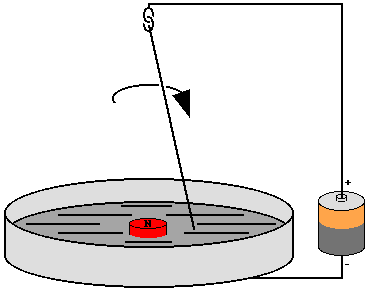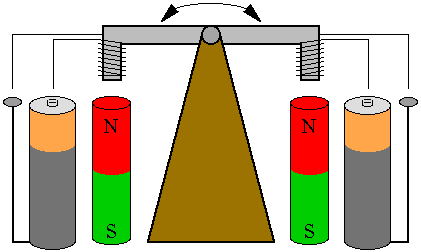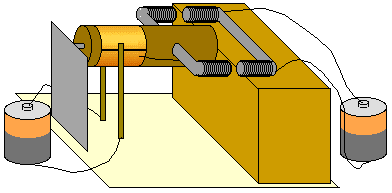|
At the most basic level, electric motors exist to
convert electrical energy into mechanical energy.
This is done by way of two interacting magnetic
fields -- one stationary, and another attached to a
part that can move. A number of types of electric
motors exist, but most BEAMbots use DC
motors1 in some form or another.
DC
motors have the potential for very high torque
capabilities (although this is generally a function
of the physical size of the motor), are easy to
miniaturize, and can be "throttled" via adjusting
their supply voltage. DC
motors are also not only the simplest, but the
oldest electric motors.
The basic principles of electromagnetic
induction were discovered in the early 1800's by
Oersted, Gauss, and Faraday. By 1820, Hans
Christian Oersted and Andre Marie Ampere had
discovered that an electric current
produces a magnetic field. The next 15 years saw a
flurry of cross-Atlantic experimentation and
innovation, leading finally to a simple DC
rotary motor. A number of men were involved in the
work, so proper credit for the first DC
motor is really a function of just how broadly you
choose to define the word "motor."
|
Michael Faraday (U.K.)
Fabled experimenter Michael Faraday
decided to confirm or refute a number of
speculations surrounding Oersted's and
Ampere's results. Faraday set to work
devising an experiment to demonstrate
whether or not a current-carrying
wire produced a circular magnetic field
around it, and in October of 1821
succeeded in demonstrating this.
Faraday took a dish of mercury and
placed a fixed magnet in the middle; above
this, he dangled a freely moving wire (the
free end of the wire was long enough to
dip into the mercury). When he connected a
battery to form a circuit,
the current-carrying
wire circled around the magnet. Faraday
then reversed the setup, this time with a
fixed wire and a dangling magnet -- again
the free part circled around the fixed
part. This was the first demonstration of
the conversion of electrical energy into
motion, and as a result, Faraday is often
credited with the invention of the
electric motor. Bear in mind, though, that
Faraday's electric motor is really just a
lab demonstration, as you can't harness it
for useful work.
Also note that if you plan on repeating
this experiment yourself, you should use
salt water (or some similar nontoxic but
conductive liquid) for the fluid, rather
than mercury. Mercury can be very
hazardous to your health, and requires
stringent precautions on its use. The BBC
has instructions on building just such a
device using salt water here.
|
|

|
|
Joseph Henry (U.S.)
It took ten years, but by the summer of
1831 Joseph Henry had improved on
Faraday's experimental motor. Henry built
a simple device whose moving part was a
straight electromagnet rocking on a
horizontal axis. Its polarity was reversed
automatically by its motion as pairs of
wires projecting from its ends made
connections alternately with two
electrochemical cells. Two vertical
permanent magnets alternately attracted
and repelled the ends of the
electromagnet, making it rock back and
forth at 75 cycles per minute.
Henry considered his little machine to
be merely a "philosophical toy," but
nevertheless believed it was important as
the first demonstration of continuous
motion produced by magnetic attraction and
repulsion. While being more mechanically
useful than Faraday's motor, and being the
first real use of electromagnets in a
motor, it was still by and large a lab
experiment.
For pictures of Henry's motor, as well
as more information on his further
explorations, check out the Smithsonian
Institution's write-up on him (part of the
Joseph Henry Papers Project) here.
|
|

|
|
William Sturgeon (U.K.)
Just a year after Henry's motor was
demonstrated, William Sturgeon invented
the commutator, and with it the first
rotary electric motor -- in many ways a
rotary analogue of Henry's oscillating
motor. Sturgeon's motor, while still
simple, was the first to provide
continuous rotary motion and contained
essentially all the elements of a modern
DC
motor. Note that Sturgeon used horseshoe
electromagnets to produce both the moving
and stationary magnetic fields (to be
specific, he built a shunt wound DC
motor).
The BBC has a good set of instructions
on building a replica of this motor
here.
|
|

|
Many later experimenters contributed a number of
further refinements; let's skip forward in time to
see just how a
modern DC motor works...
Notes:
1. Note that gearmotors are
generally just DC motors with an attached gearhead;
servos in turn are gearmotors with control
electronics attached.
|


